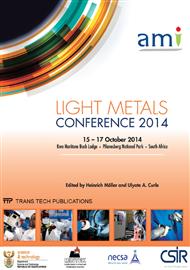[1]
H.C. Donkersloot, J.H.N. van Vucht, Martensitic transformations in Gold-Titanium, Palladium-Titanium and Platinum-Titanium alloys near the equiatomic composition, J. Less-Common Metals. 20 (1970) 83-91.
DOI: 10.1016/0022-5088(70)90092-5
Google Scholar
[2]
T. Biggs, M.B. Cortie, M.J. Witcomb, L.A. Cornish, Martensitic transformations, Microstructure, and Mechanical Workability of TiPt, Metall. & Mater. Trans. 32A (2001) 1881-1886.
DOI: 10.1007/s11661-001-0001-5
Google Scholar
[3]
K. Otsuka, X. Ren, Physical metallurgy of Ti-Ni based shape memory alloys, Prog. Mater. Scie. 50 (2005) 511-678.
DOI: 10.1016/j.pmatsci.2004.10.001
Google Scholar
[4]
P.R. Soni, Mechanical Alloying: Fundamentals and Apllications, Cambridge International Science Publishing, Cambridge, (2001).
Google Scholar
[5]
R.B. Schwarz, C.C. Koch, Formation of amorphous alloys by the mechanical alloying of crystalline powders of pure metals and powders of intermetallics, App. Phys. Lett. 49 (1986) 146-148.
DOI: 10.1063/1.97206
Google Scholar
[6]
W.L. Johnson, Thermodynamic and kinetic aspets of crystal to glass transformation in metallic materials, Prog. Mater. Sci. 30 (1986) 81-134.
Google Scholar
[7]
M.L. Mahlatji, S. Chikosha, H.K. Chikwanda, W.E. Stumpf, C.W. Siyasiya, Formation of amorphous TiPt alloy by mechanical alloying, J. SAIMM. 114 (2014) 167-172.
DOI: 10.4028/www.scientific.net/amr.1019.372
Google Scholar
[8]
L. Battezzati, G. Cocco, L. Schiffini, S. Enzo, Thermal properties of mechanically alloyed Ni50Ti50 powder prepared by mechanical alloying, Mater. Scie. & Eng. 97 (1988) 121-124.
DOI: 10.1016/b978-1-85166-971-4.50026-8
Google Scholar
[9]
R.B. Schwarz, R.R. Petrich, Calorimetry study of the synthesis of amorphous Ni-Ti alloys by mechanical alloying, J. Less-Common Metals, 140 (1988) 171-184.
DOI: 10.1016/0022-5088(88)90379-7
Google Scholar
[10]
T. Itsukaichi, S. Ohura, J.G. Cabanas-Moreno, M. Umemoto, I. Okane, Mechanically alloyed Ti50Ni50 and its transformation by thermal treatments, J. Mater. Scie. 29 (1994) 1481-1486.
DOI: 10.1007/bf00368912
Google Scholar
[11]
Y. Terunuma, M. Nagumo, Structural relaxation in amorphous Ti50Ni50 alloy prepared by mechanical alloying. Mater. Trans. JIM 36 (1995) 842-847.
DOI: 10.2320/matertrans1989.36.842
Google Scholar
[12]
L. Battezzati, S. Enzo, L. Schiffini, G. Cocco, J. Less-Common Metals. 145 (1988) 301-308.
DOI: 10.1016/0022-5088(88)90288-3
Google Scholar
[13]
R. de Reus, F.W. Saris, The crystallisation temperature of amorphous transition-metal alloys, Mater. Lett. 9 (1990) 487-493.
DOI: 10.1016/0167-577x(90)90093-2
Google Scholar
[14]
G.S. Firstov, Y. N. Koval. J. van Humbeeck, R. Portier, P. Vermaut, P. Ochin, Phase transformations in Zr-29. 56% at. %Cu-19. 85at. %Ni melt-spun high-temperature shape memory alloy, Mater. Scie. & Eng. A 438-440 (2006) 816-820.
DOI: 10.1016/j.msea.2006.02.203
Google Scholar


